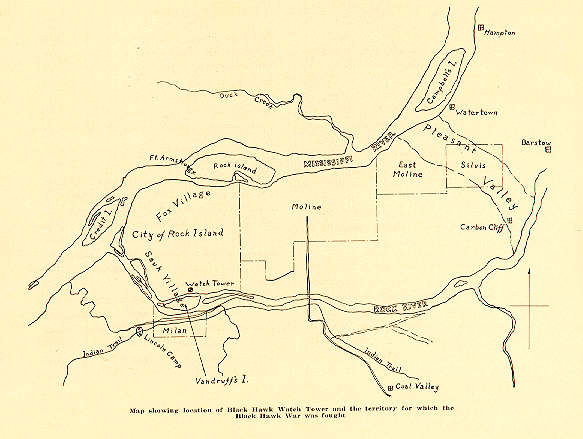During the War of 1812, the forces of Great Britain and its colonies, in present-day Canada, were engaged against those of the United States, with major battles on the Great Lakes and surrounding remote lands. Preoccupied with Napoleon in Europe, the British depended upon Native American allies to help them wage war in such areas. Colonel Robert Dickson, an English fur trader, amassed a sizable force of Native Americans at Green Bay to assist the British in operations around the Great Lakes. Most were from the Potawatomi, Ho-Chunk, Kickapoo, and Ottawa tribes. Black Hawk, now 45 years old, was recruited by Dickson along with his band of about 200 Sauk warriors to assist in the fight. Black Hawk was only too happy to help in trying to rid his land of the hated Americans.
The British, he later detailed in his autobiography, were cheap, but they could be trusted to hold to their agreements. The Americans were perhaps less cheap, but could not be trusted. The heavily disputed and clearly fraudulent treaty of 1804, which ceded an area the size of the state of Minnesota to then Lt. Governor William Henry Harrison and the Indiana Territory, was proof that the Americans were dishonorable liars and thieves, all the way to the ‘Chief-of-Chiefs’, Thomas Jefferson and his Indian-fighting successor Andrew Jackson.
The British, he later detailed in his autobiography, were cheap, but they could be trusted to hold to their agreements. The Americans were perhaps less cheap, but could not be trusted. The heavily disputed and clearly fraudulent treaty of 1804, which ceded an area the size of the state of Minnesota to then Lt. Governor William Henry Harrison and the Indiana Territory, was proof that the Americans were dishonorable liars and thieves, all the way to the ‘Chief-of-Chiefs’, Thomas Jefferson and his Indian-fighting successor Andrew Jackson.
When Black Hawk arrived in Green Bay, Colonel Dickson gave him command of all the Natives gathered there, and presented him with a silk flag, a medal, and a written certificate of good behavior and alliance with the British. In addition, Dickson commissioned Black Hawk at the rank of Brevet Brigadier General. Black Hawk preserved that certificate for 20 years; it was found by US forces after the Battle of Bad Axe, along with a flag similar to the one Dickson had given to him.
Between 1812 and 1815, Black Hawk and the other Native warriors in his command fought many engagements on the borders of Lake Erie, including the Battle of Frenchtown, Fort Meigs, and the attack on Fort Stephenson. The newly formed United States repulsed the British and the Indian Confederacy, with high casualties suffered by the British and their allies. Black Hawk, an important leader in the alliance, was nonetheless subordinate to Tecumseh, a Shawnee tribal leader, and to the British Leaders. The battles were fought in traditional British style, and they suffered the same defeats, for the same reasons, that lost them the Americas in the first place three decades earlier.
Black Hawk despaired over the many lives lost due to British attack methods; soon after, he quit the war to return home. But back in Saukenuk, he found that his rival Keokuk had become the tribe's war leader. In disgust, Black Hawk rejoined the British effort toward the end of the war, fighting alongside British forces in campaigns along the Mississippi River near the Illinois Territory. At the Battle of Credit Island, within sight of the village of Saukenuk, and by harassing U.S. troops at Fort Johnson, Black Hawk finally succeeded in pushing the Americans out of the upper Mississippi River valley.
In the end, the war lost, Black Hawk was coerced into signing a peace treaty with the Americans in May 1816 that re-affirmed the treaty of 1804, including the vast area of ceded territory. Being little educated with written English, and unfamiliar with the legal language included in the peace treaty document, Black Hawk was unaware that he too had been tricked into giving away his beloved homeland.
As a consequence of the treaties of 1804 and 1816, the Sauk and Fox tribes had ceded their lands in Illinois, and in 1828 were forced to move west of the Mississippi. Black Hawk and other tribal members disputed the treaty, stating leaders had signed it without full tribal authorization. Driven by hunger and angered by the loss of his birthplace, between 1830 and 1831, Black Hawk led a number of peaceful incursions back across the Mississippi to Illinois, intent on returning to his familiar hunting grounds and tribal allies. He was persuaded to return west each time without bloodshed.
(Key Terms: Ma-Ka-Tai-Me-She-Kia-Kiak, Black Sparrow Hawk, Black Hawk, 1767, Saukenuk, Pyesa, Rock Island, Black Hawk’s Watch Tower, Black Hawk State Historic Site, Hauberg Museum, Sauk, Sac, Meskwaki, Fox, Rock River, Sinnissippi River, Mississippi River, War of 1812, British Band, Great Britain, Treaty of 1804, Treaties, Ceded Land, William Henry Harrison, Quashquame, Keokuk, Fort Armstrong, Samuel Whiteside, Black Hawk War of 1832, Black Hawk Conflict, Scalp, Great Sauk Trail, Black Hawk Trail, Prophetstown, Wabokieshiek, White Cloud, The Winnebago Prophet, Ne-o-po-pe, Dixon’s Ferry, Isaiah Stillman, The Battle of Stillman’s Run, Old Man’s Creek, Sycamore Creek, Abraham Lincoln, Chief Shabbona, Felix St. Vrain, Lake Koshkonong, Fort Koshkonong, Fort Atkinson, Henry Atkinson, Andrew Jackson, Lewis Cass, Winfield Scott, Chief Black Wolf, Henry Dodge, James Henry, White Crow, Rock River Rapids, The Four Lakes, Battle of Wisconsin Heights, Benjamin Franklin Smith, Wisconsin River, Kickapoo River, Soldier’s Grove, Steamboat Warrior, Steamship Warrior, Fort Crawford, Battle of Bad Axe, Bad Axe Massacre, Joseph M. Street, Antoine LeClaire, Native American, Indian, Michigan Territory, Indiana Territory, Louisiana Territory, Osage, Souix, Potawatomi, Ojibwe, Ottawa, Ho-Chunk)




No comments:
Post a Comment
Note: Only a member of this blog may post a comment.